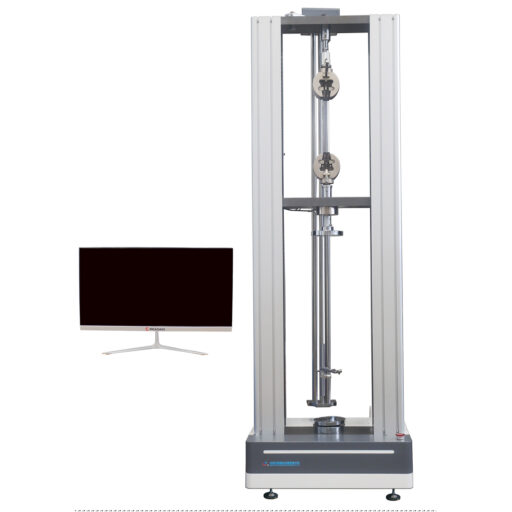I. Introduction: The Key to Accurate Elongation Testing
A tensile testing machine is one of the core instruments for accurately measuring the elongation performance of rubber, plastic, and film materials. Elongation, as an important indicator of ductility, flexibility, and deformation resistance, plays a vital role in material R&D, formulation optimization, and quality control. However, many users encounter problems during testing, such as inconsistent results, unstable data, abnormal fracture positions, or significant deviations in elongation values. In some cases, results vary between operators despite using the same machine.
The root cause often lies beyond the equipment itself. Critical factors such as test speed, grip type, clamping method, gauge length setup, and sample preparation all have a major impact on the final result. Without understanding these details, repeated testing may still yield inaccurate or misleading results.
So, how can a tensile testing machine be used to measure elongation with true precision? The following sections will explain the essential steps—from physical definitions to equipment configurations.

Tensile Testing Machine
Designed for tensile testing of non-metal materials like rubber, plastic, and film, featuring high-precision sensors and analysis software.
View Product DetailsIII. What Is Elongation and Why Do Misunderstandings Occur?
Elongation refers to the percentage increase in length a material undergoes before breaking under tension. It is commonly calculated as:
Elongation (%) = (Final length – Original length) ÷ Original length × 100%
Two common misunderstandings often arise:
- “The longer it stretches, the better the material” — In reality, elongation alone doesn’t determine quality; it must be evaluated alongside tensile strength, modulus, and failure mode.
- “The machine calculates everything correctly” — If gauge length, speed, or break point detection are improperly set, the results may be unreliable or misleading.
Understanding the physical meaning of elongation is the first step toward accurate testing.
IV. How to Configure a Tensile Testing Machine for Elongation Measurement
To achieve accurate elongation testing for rubber, plastic, and film materials, the following configuration points are essential:
1️⃣ Grip Selection
- Rubber: Use pneumatic grips or wedge grips with anti-slip surfaces to prevent sliding or shear failure.
- Film: Use large-area, low-pressure grips with protective pads to avoid tearing.
- Plastic: Standard wedge grips are fine, but stress concentration at edges should be avoided.
2️⃣ Extensometer and Gauge Length Setup
- For high-elongation materials like rubber or film, a non-contact video extensometer is highly recommended.
- If relying solely on crosshead displacement, ensure the system is well-synchronized and stable within the gauge section.
3️⃣ Test Speed
- Speed has a significant impact on results. Too fast can cause premature failure or inflated elongation.
- Reference test speeds from standards: ISO 37 recommends 500 mm/min for rubber; ASTM D882 recommends 50–500 mm/min for plastic film, depending on thickness.
4️⃣ Test Mode Selection
- Choose modes like “stretch to break” or “maximum strain hold.”
- Enable “automatic break detection” to avoid elastic rebound errors.
V. Material-Specific Testing Challenges
✅ Rubber
- Extremely high elongation and rapid rebound—requires high-speed data acquisition and soft-start gripping.
- Highly sensitive to ambient temperature; ensure a stable environment.
✅ Plastic
- Certain plastics (e.g., PP) show necking effects and unpredictable break points.
- Recommended: average 3–5 test specimens to ensure data reliability.
✅ Film
- Prone to edge tearing near grips due to extreme thinness.
- Recommended: cut standard dumbbell-shaped samples, polish edges, and pre-stretch to release residual stress.
VI. Standards and Testing Guidance for Elongation
(With Anchor Text External Links)
Different materials require specific international standards to guide elongation testing. Key references include:
- 📘 ISO 37: Rubber, vulcanized or thermoplastic — Tensile properties
- 📘 ASTM D882: Tensile Properties of Thin Plastic Sheeting
These standards provide clear rules for sample shape, gauge length, test speed, grip type, and calculation methods. Always refer to the correct standard before setting up your tensile testing machine.
VII. Final Thoughts: Elongation Shouldn’t Be a Blind Spot
Elongation might seem like a simple metric, but it’s one of the easiest to mismeasure. Whether you’re a materials developer, quality engineer, or procurement specialist, understanding the elongation testing process is essential. One misconfigured setting could invalidate an entire batch of test results.
If you’re currently choosing a tensile testing machine, or if you already have one but are unsure how to configure it properly, feel free to reach out. We offer tailored parameter setup recommendations and sample test guides to help you test accurately.
